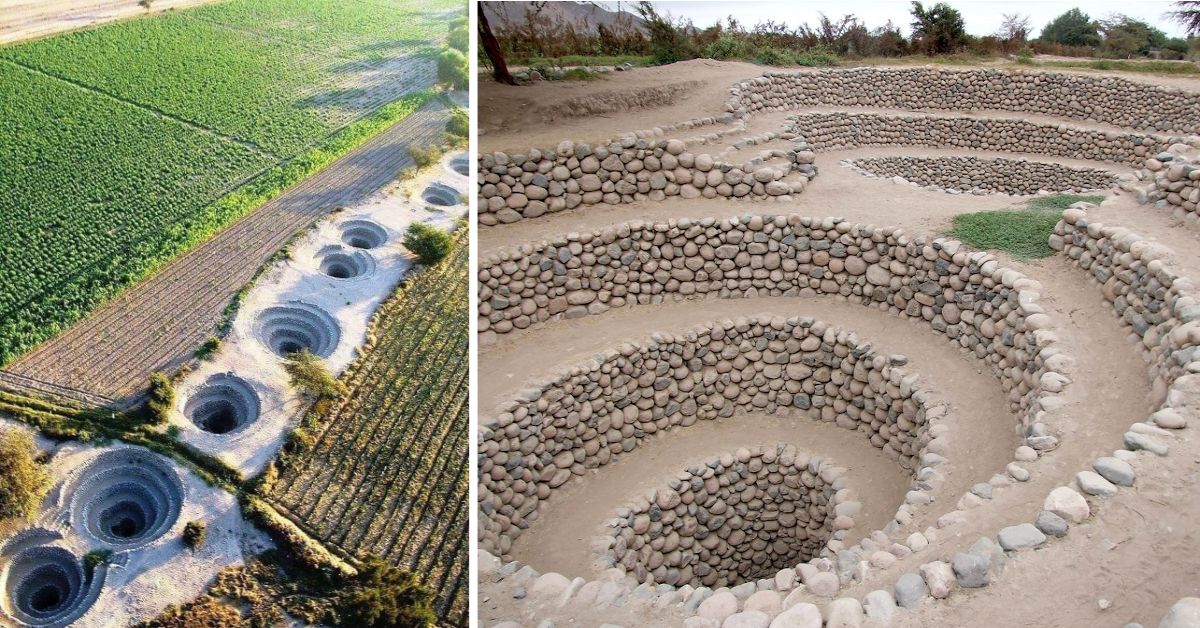Built by the Nazca people during the pre-Columbian period of Peruvian history, the Cantalloc Aqueducts continue to serve their original purpose, with local farmers still relying on this them to bring water to the arid region.

Recently, a team of researchers led by Rosa Lasaponara from the Institute of Methodologies for Environmental Analysis examined satellite images to find out whether they could offer new insight into the existence of the “puquios” – a series of aqueducts located 4 kilometres (2.5 mi) west of the city of Nazca, Peru. Built by the Nazca culture, there are about 40 such aqueducts in existence, and the Nazca used themall year round.
These structures in the lowlands of Peru were built just 2.5 miles (4 km) to the east of the famous Nazca lines. And they aren’t only close geographically, the structures may also share a common theme as there have been speculations that the lines played a symbolic role in the quest for water – the very resource the Nazca aqueducts were meant to harness. Just like the Nazca lines, these canals are believed to have served some sort of religious purpose, too, besides their practical use of making the soil more welcoming to crops.

The discovery of the aqueducts revealed just how advanced the Nazca civilization was. These spiral structures called ‘puquios’ were part of a hydraulic system to retrieve and channel water. The uniquely shaped holes allowed wind to blow into a series of underground canals, forcing water from underground aquifers into areas where it was most needed. The puquios were such a great construction that 30 of them continue to be utilized by farmers to this day.
Such a sophisticated and long-lasting network is evidence of its architects’ understanding of the surrounding region’s geology and annual characteristics in terms of water supply.

The Nazca culture flourished between c. 100 BC – 800 AD in the river valleys of the Rio Grande de Nazca drainage and the Ica Valley in the arid, southern coast of Peru. Strongly influenced by the preceding Paracas culture (known for their extremely complex textiles), the Nazca produced an array of crafts and technologies such as ceramics, textiles, geoglyphs – and, of course, aqueducts.
Apart from these amazing water networks, the Nazca people who once inhabited the Ica Region of Peru are mostly known for the Nazca Lines, immense designs in the desert whose purpose is unknown. Just recently, it turned out that the oldest one of these lines is a rather chubby cat.

Similarly to other Coastal Andean peoples in South America, the Nazca were keen observers of the vast ocean world. The whale tooth below, from which a captivating lady has been carved, stands as an example.
The salty ocean and its unusual creatures constituted a dyadic opposition to the earth with its fresh waters. The carving of a ritual figurine from the tooth of a gigantic marine creature certainly carried extra spiritual significance.

But back to the Nasca’s incredible aqueduct systems. They built those to carry water from springs up in the mountains – the name ‘puquios’ stands for the spiral-shaped origin points.
Located very far up the sides of the mountains, these springs are generally covered with wooden roofs and lined with stones. From the puquios, water is driven down through deep trenches to lowland fields.

Built to form giant curves, the paths of the aqueducts are easy to follow. By building their waterways so curvy, the Nazca actually prevented flooding by ensuring that the water would not flow too quickly with the snow melting in the spring.
These spirals are called ‘ojos’, which means ‘eyes’ in Spanish. You can actually walk into them, spiraling all the way down on stone steps to the cooling wells at the bottom. The aqueducts require annual maintenance though, and the farmers descend from the ‘ojos’ to clear out the canals. In return, they have an area that has a lush vegetation – a cool place to hike, with spectacular views of mountains in every direction.

Sources: 1, 2, 3, 4, 5
